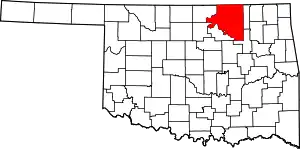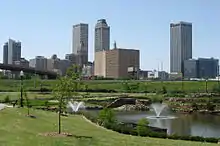Pawhuska, Oklahoma
Pawhuska is a city in and the county seat of Osage County, Oklahoma, United States.[5] It was named after the 19th-century Osage chief, Paw-Hiu-Skah, which means "White Hair" in English.[6] The Osage tribal government, which opened offices in Pawhuska in 1872 when its reservation was established in Indian Territory, continues to be based in Pawhuska.
Pawhuska, Oklahoma | |
|---|---|
.jpg.webp) Historic Downtown Pawhuska (2005) | |
 Location of Pawhuska, Oklahoma | |
| Coordinates: 36°40′9″N 96°19′59″W | |
| Country | United States |
| State | Oklahoma |
| County | Osage |
| Area | |
| • Total | 3.65 sq mi (9.45 km2) |
| • Land | 3.63 sq mi (9.41 km2) |
| • Water | 0.02 sq mi (0.04 km2) |
| Elevation | 820 ft (250 m) |
| Population (2010) | |
| • Total | 3,584 |
| • Estimate (2019)[2] | 3,415 |
| • Density | 940.25/sq mi (363.00/km2) |
| Time zone | UTC-6 (Central (CST)) |
| • Summer (DST) | UTC-5 (CDT) |
| ZIP codes | 74056 |
| Area code(s) | 539/918 |
| FIPS code | 40-57600[3] |
| GNIS feature ID | 1096476[4] |
One of the United States' first Boy Scout troops was organized here in 1909.[6]
History
The town, originally known as Deep Ford,[7] was established in 1872 with the reservation for the Osage Nation, part of Indian Territory. The Osage Indian Agency was located along Bird Creek. One of the three main bands of the tribe settled here. Traders followed, building stores during 1872 and 1873. Pawhuska's first newspaper, the Indian Herald (also known as Wah-Sha-She News.), was founded in 1875 by George Edward Tinker, an Osage who became the father of Clarence L. Tinker, highest-ranking Native American officer in the US Army.[8] The first post office opened in 1876.[6]
The Midland Valley Railroad reached Pawhuska in September 1905. By the time of statehood in 1907, the town population was 2,407.[6]
The first Boy Scout troop is claimed to have been organized in Pawhuska in May 1909 by John F. Mitchell, a missionary priest from England sent to St. Thomas Episcopal Church by the Church of England.[9] On Independence day weekend 2009, the Pawhuska Boy Scout troop celebrated its centennial with a mini-jamboree attended by over 300 Scouts from across the United States.
During the Osage oil boom of the 1910s and 1920s, Pawhuska was the site of big-money public auctions of oil and gas leases under the so-called “Million Dollar Elm” next to the Osage Council House.[10] The population grew to 6,414 by 1920. The Atchison, Topeka and Santa Fe Railroad extended its line from Owen, a community in Washington County, to Pawhuska in 1923. As the oil boom declined and the Great Depression set in, the population declined. The steady decline has continued to the present.
Geography
Pawhuska is located at 36°40′9″N 96°19′59″W (36.669194, -96.333048).[11] It is 57 miles (92 km) northwest of Tulsa.[6] According to the United States Census Bureau, the city has a total area of 3.8 square miles (9.8 km2), all land.
The Tallgrass Prairie Preserve is north of the town.[6]
Demographics
| Historical population | |||
|---|---|---|---|
| Census | Pop. | %± | |
| 1910 | 2,776 | — | |
| 1920 | 6,414 | 131.1% | |
| 1930 | 5,931 | −7.5% | |
| 1940 | 5,443 | −8.2% | |
| 1950 | 5,331 | −2.1% | |
| 1960 | 5,414 | 1.6% | |
| 1970 | 4,278 | −21.0% | |
| 1980 | 4,771 | 11.5% | |
| 1990 | 3,825 | −19.8% | |
| 2000 | 3,629 | −5.1% | |
| 2010 | 3,584 | −1.2% | |
| 2019 (est.) | 3,415 | [2] | −4.7% |
| U.S. Decennial Census | |||
Pawhuska is in the Tulsa metropolitan area, which includes part of Osage County.
The population of the city was 3,589 at the 2010 census, a decline of 1.2 percent from 3,629 at the 2000 census.[12]
As of the census[3] of 2000, there were 3,629 people, 1,513 households, and 954 families residing in the city. The population density was 966.4 people per square mile (372.7/km2). There were 1,802 housing units at an average density of 479.9 per square mile (185.0/km2). The racial makeup of the city was 64.98% White, 2.78% African American, 25.46% Native American, 0.25% Asian, 0.52% from other races, and 6.01% from two or more races. Hispanic or Latino of any race were 1.85% of the population.
There were 1,513 households, out of which 29.5% had children under the age of 18 living with them, 44.7% were married couples living together, 14.4% had a female householder with no husband present, and 36.9% were non-families. 33.8% of all households were made up of individuals, and 18.1% had someone living alone who was 65 years of age or older. The average household size was 2.37 and the average family size was 3.02.
In the city, the population was spread out, with 27.8% under the age of 18, 7.3% from 18 to 24, 23.0% from 25 to 44, 22.2% from 45 to 64, and 19.8% who were 65 years of age or older. The median age was 39 years. For every 100 females, there were 88.1 males. For every 100 females age 18 and over, there were 78.2 males.
The median income for a household in the city was $25,156, and the median income for a family was $31,599. Males had a median income of $25,682 versus $17,690 for females. The per capita income for the city was $13,916. About 13.7% of families and 17.5% of the population were below the poverty line, including 22.3% of those under age 18 and 14.9% of those age 65 or over.
Economy
Other than cattle ranches nearby, local employment consisted primarily of a brick plant, a creamery, an ice factory, and a rock crusher.[6] The Osage Nation has opened a gaming casino here, hoping to generate revenue for the tribe.
In 2016, "Pioneer Woman" Ree Drummond opened The Mercantile on Main Street. The establishment includes a store and restaurant which serves up to 6,000 people per day.[13] Drummond operates a boutique hotel,[14] The PW Boarding House, and also offers tours of the blogger-turned-Food Network star's cooking lodge on nearby Drummond Ranch, thus solidifying her place as a major economic force in Pawhuska.
Media
KPGM Radio, 1500 AM featuring local news until 8:00am and the Sports Animal Format out of Oklahoma City.
KOSG, 103.9 FM featuring Southern Gospel music.
The local newspaper is the Pawhuska Journal-Capital.[15] Its roots go back to two papers which subsequently merged: The Capital, started on January 30, 1904, and The Journal, established December 10, 1904.[16] The Journal-Capital has been in continuous publication under that name since April 6, 1925.[16]
Infrastructure
Transportation
Pawhuska is served by one U.S. Highway and two state highways.
- US-60 is an east–west highway that enters Pawhuska on the east side of town at the junction of SH-99/SH-11 and follows Main Street. The highway will exit Pawhuska to the west near Elk Lodge Drive.
- SH-11 is a predominately east–west state highway that enters Pawhuska on the east side of town at the junction of US-60/OK-99 and runs along Main Street. Like US-60, the highway will exit Pawhuska to the west near Elk Lodge Drive.
- SH-99 is a north–south state highway. SH-99 will skirt Pawhuska on the east side of town and run concurrently with US-60 to Main Street, where it will continue south. SH-99 will then overlap OK-11 until the highway exits Pawhuska near Osage County Road 2625.
Pawhuska Municipal Airport, FAA Identifier H76, is a single runway airport located on US-60 and Osage County Road 4291, about four miles west of the city.[17] Runway 35/17 is paved, 3,200-foot-long (980 m) and 60-foot-wide (18 m).[17] The airport opened in September 1945.[17]
Notable people
- Louis F. Burns, historian and author of 13 books about the Osage Indians[20]
- Bill Campbell, American player of gridiron football
- G. R. Carter, jockey
- Ree Drummond, "Accidental" blogger, author, food writer, chef, photographer, television personality and local businesswoman
- Lucy Tayiah Eads, Kaw tribal chief[21]
- Ben Johnson, actor
- M. John Kane IV, Oklahoma Supreme Court Justice
- John Joseph Mathews, historian and author
- William Salyers, actor
- Mitch Schauer, creator of The Angry Beavers
- Larry Sellers, actor
- Shockley Shoemake, Oklahoma state legislator and lawyer
- Clarence L. Tinker, United States Air Force general and namesake of Tinker Air Force Base, near Oklahoma City
In popular culture
Tracy Letts' Pulitzer Prize-winning play August: Osage County (2007) is set in a country house near Pawhuska. The 2013 film August: Osage County was set in Osage County. Terence Malick's film To the Wonder (2012) was filmed in parts of Pawhuska, as well as in Bartlesville and parts of Skiatook.
References
- "2019 U.S. Gazetteer Files". United States Census Bureau. Retrieved July 28, 2020.
- "Population and Housing Unit Estimates". United States Census Bureau. May 24, 2020. Retrieved May 27, 2020.
- "U.S. Census website". United States Census Bureau. Retrieved 2008-01-31.
- "US Board on Geographic Names". United States Geological Survey. 2007-10-25. Retrieved 2008-01-31.
- "Find a County". National Association of Counties. Archived from the original on May 31, 2011. Retrieved 2011-06-07.
- Jon D. May, "Pawhuska." Encyclopedia of Oklahoma History and Culture. Accessed 30 Jan 2010
- Jon D. May, "Osage County", Encyclopedia of Oklahoma History and Culture. Retrieved September 25, 2011.
- "Major General Clarence L. Tinker" Archived 2013-02-19 at the Wayback Machine, Retrieved January 17, 2012.
- Osage County Historical Museum
- "Million Dollar Elm". American Oil and Gas Historical Society. Retrieved September 3, 2020.
- "US Gazetteer files: 2010, 2000, and 1990". United States Census Bureau. 2011-02-12. Retrieved 2011-04-23.
- "MuniNet Guide: Pawhuska, Oklahoma". Archived from the original on 2013-10-14. Retrieved 2011-09-25.
- "The Pioneer Woman Serves 6,000 People a Day at Her Restaurant". Eater. Retrieved 2018-07-03.
- "The Pioneer Woman Boarding House". The Pioneer Woman Boarding House. Retrieved 2018-07-03.
- "Homepage". Pawhuska Journal-Capital. Retrieved August 5, 2020.
- "About Us". Pawhuska Journal-Capital. Retrieved August 5, 2020.
- "Pawhuska Municipal Airport". AirNav.com. Retrieved August 5, 2020.
- https://www.usnews.com/education/best-high-schools/oklahoma/districts/pawhuska/pawhuska-hs-16189
- https://www.maxpreps.com/m/high-schools/pawhuska-huskies-(pawhuska,ok)/football/team_preview.htm#general_information
- "Osage historian, lecturer Louis Burns dies at 92". Pawhuska Journal-Capital. Osage Nation Museum. 2012-05-22. Archived from the original on 2012-07-11. Retrieved 2012-06-09.
- "Lucy Tayiah Eads". Kansas Historical Society. Retrieved 10 April 2014.
Further reading
- Franks, Kenny A. (1989). The Osage Oil Boom. Oklahoma City: Oklahoma Heritage Association. OCLC 84216747.
- Osage County Profiles. Pawhuska, Okla.: Osage County Historical Society. 1978.
- "Pawhuska". Vertical File. Oklahoma City: Research Division, Oklahoma Historical Society.
- Warehime, Les (2000). History of Ranching the Osage. Tulsa, Okla.: W. W. Publishing. OCLC 865808685.
External links
| Wikimedia Commons has media related to Pawhuska, Oklahoma. |


